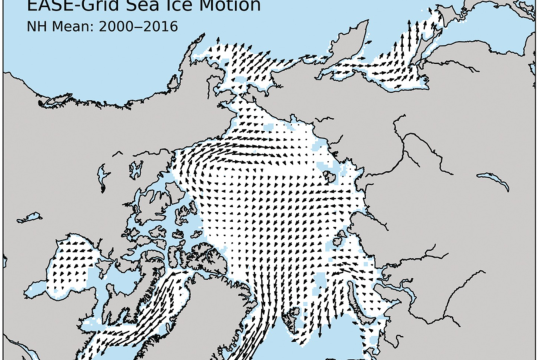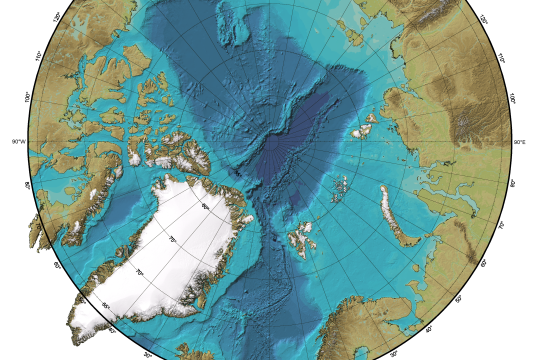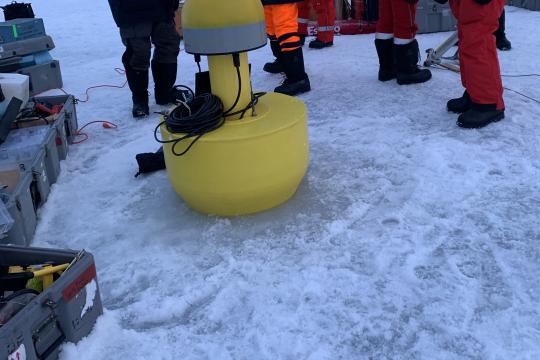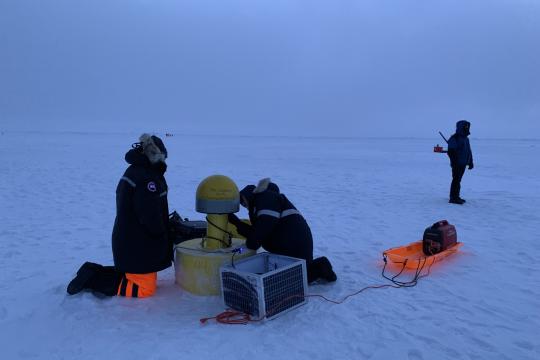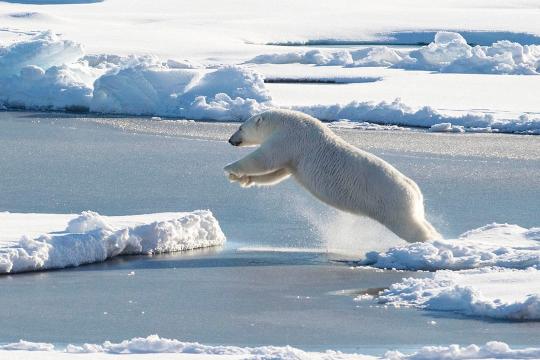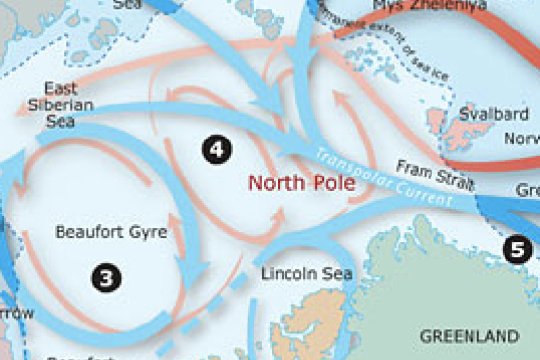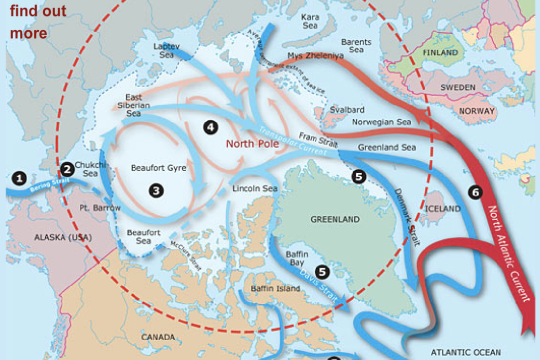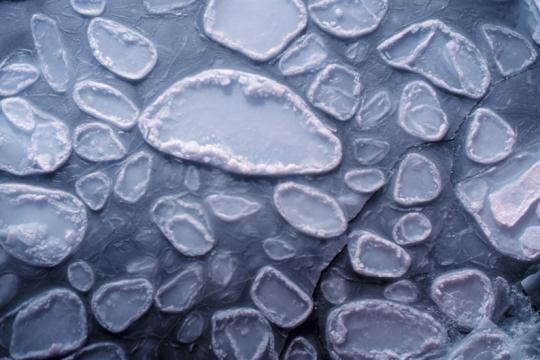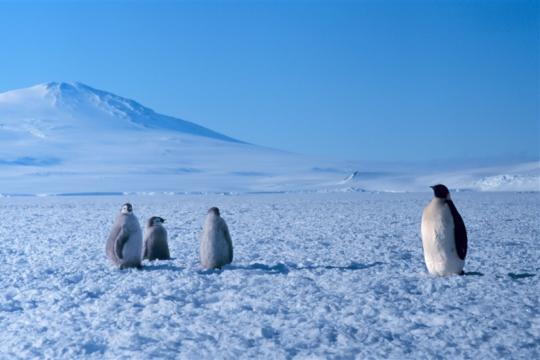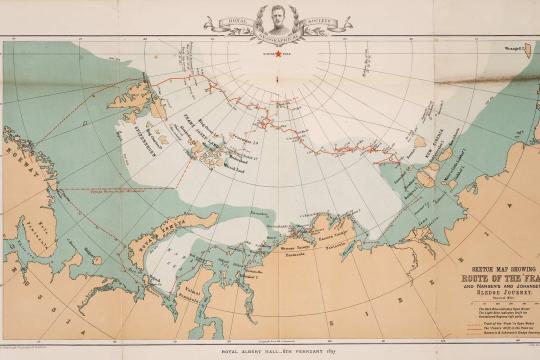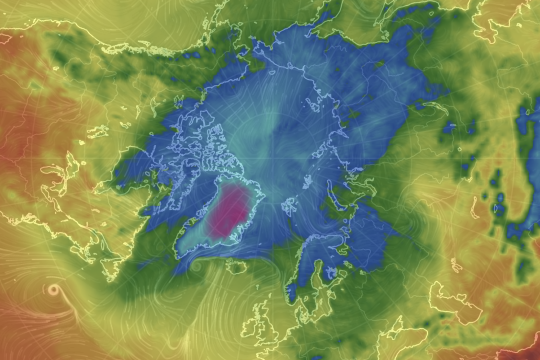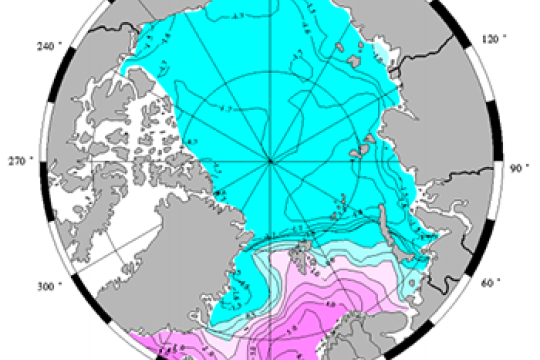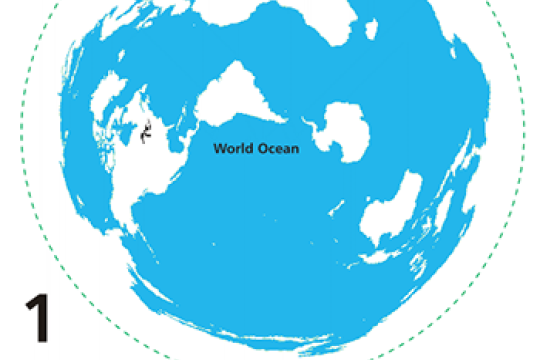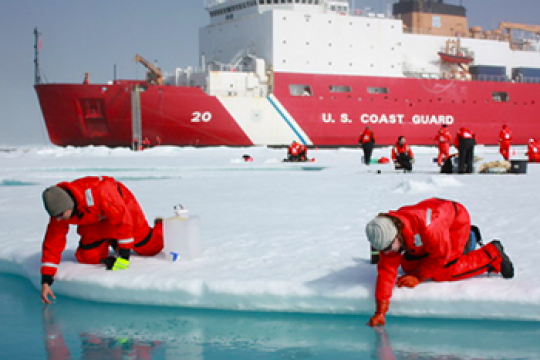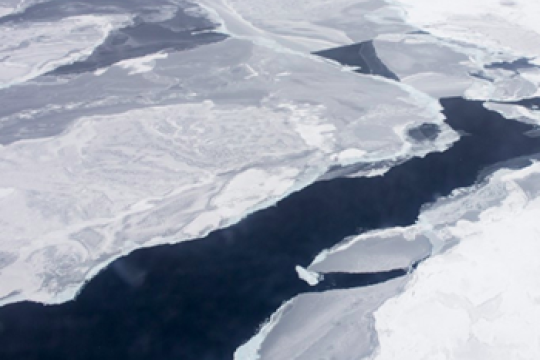Oceans and ocean circulation
New Ice, New Problems
The sea ice in the Arctic is becoming newer and thinner. What kinds of impacts could this have on the Arctic region? Photo credit: Jan Rohde/AWI
Lesson plan
Subject: Expeditions, mosaic monday, Obtaining and evaluating information, Oceans and ocean circulation, Sea ice
Grade Level: Middle School, High School, University/college
Developer: CIRES
The sea ice in the Arctic is becoming newer and thinner. What kinds of impacts could this have on the Arctic region? Photo credit: Jan Rohde/AWI
Lesson plan
Subject: Expeditions, mosaic monday, Obtaining and evaluating information, Oceans and ocean circulation, Sea ice
Grade Level: Middle School, High School, University/college
Developer: CIRES
Quick Bite: Arctic Current Events
Can you identify currents in the Arctic Ocean using ocean motion vector maps? Figure credit: NASA/NSIDC/DAAC/University of Colorado Tschudi, Meier, Stewart
Quick bite
Subject: Earth science, mosaic monday, Oceans and ocean circulation
Grade Level: High School
Developer: CIRES
Can you identify currents in the Arctic Ocean using ocean motion vector maps? Figure credit: NASA/NSIDC/DAAC/University of Colorado Tschudi, Meier, Stewart
Quick bite
Subject: Earth science, mosaic monday, Oceans and ocean circulation
Grade Level: High School
Developer: CIRES
Quick Bite: The Arctic vs. the World
How does the Arctic Ocean's bathymetry compare to Earth's other ocean basins? Learn more in this Quick Bite activity.
Project of Mosaic Quick bite
Subject: Earth science, Geography, mosaic monday, Oceans and ocean circulation
Grade Level: Middle School, High School
Developer: CIRES
How does the Arctic Ocean's bathymetry compare to Earth's other ocean basins? Learn more in this Quick Bite activity.
Project of Mosaic Quick bite
Subject: Earth science, Geography, mosaic monday, Oceans and ocean circulation
Grade Level: Middle School, High School
Developer: CIRES
Quick Bite: Buoy Structure and Function
In this Quick Bite activity, your students will read about SIMB buoys, watch a video of a buoy installation during the 2019-2020 MOSAiC expedition, and then discuss the structure and function of a buoy. Photo credit: Anne Gold, CIRES/CU Boulder
Project of Mosaic Quick bite
Subject: Constructing explanations, Engineering and technology, Expeditions, mosaic monday, Oceans and ocean circulation
Grade Level: Middle School, High School, University/college
Developer: CIRES
In this Quick Bite activity, your students will read about SIMB buoys, watch a video of a buoy installation during the 2019-2020 MOSAiC expedition, and then discuss the structure and function of a buoy. Photo credit: Anne Gold, CIRES/CU Boulder
Project of Mosaic Quick bite
Subject: Constructing explanations, Engineering and technology, Expeditions, mosaic monday, Oceans and ocean circulation
Grade Level: Middle School, High School, University/college
Developer: CIRES
Tracking Ice: Arctic Sea Ice and Mathematics Curriculum
Through the course of four modules, students will estimate the accuracy of their forecast and determine if it is fit for the purpose of guiding a search and rescue mission. After building their forecasting model, students will know how to access the coordinates of buoys tracked by the International Arctic Buoy Program (IABP) to make a sea ice drift forecast.
Lesson plan
Subject: Climate, Computational thinking, Developing and using models, Earth science, Oceans and ocean circulation, Sea ice
Grade Level: High School
Developer: SMILE Oregon State
Through the course of four modules, students will estimate the accuracy of their forecast and determine if it is fit for the purpose of guiding a search and rescue mission. After building their forecasting model, students will know how to access the coordinates of buoys tracked by the International Arctic Buoy Program (IABP) to make a sea ice drift forecast.
Lesson plan
Subject: Climate, Computational thinking, Developing and using models, Earth science, Oceans and ocean circulation, Sea ice
Grade Level: High School
Developer: SMILE Oregon State
Know Your Ocean: Polar Research
Learn more about polar topics like glaciers and ice sheets, Arctic sea life, and sea ice in these polar research educational modules from the Woods Hole Oceanographic Institution.
Subject: Earth science, Ecosystems, Geography, Life science, Obtaining and evaluating information, Oceans and ocean circulation, Physical science, Sea ice
Grade Level: Middle School, High School, University/college, Adult
Learn more about polar topics like glaciers and ice sheets, Arctic sea life, and sea ice in these polar research educational modules from the Woods Hole Oceanographic Institution.
Subject: Earth science, Ecosystems, Geography, Life science, Obtaining and evaluating information, Oceans and ocean circulation, Physical science, Sea ice
Grade Level: Middle School, High School, University/college, Adult
Polar Discovery: Arctic Ocean Circulation
The Arctic Ocean is a unique part of the globe, covered by ice much of the year and fairly isolated from the other oceans. Learn about how water in the Arctic Ocean moves around and why using this interactive graphic from the Woods Hole Oceanographic Institution.
Data visualization
Subject: Earth science, Geography, Obtaining and evaluating information, Oceans and ocean circulation, Physical science
Grade Level: Middle School, High School, University/college, Adult
The Arctic Ocean is a unique part of the globe, covered by ice much of the year and fairly isolated from the other oceans. Learn about how water in the Arctic Ocean moves around and why using this interactive graphic from the Woods Hole Oceanographic Institution.
Data visualization
Subject: Earth science, Geography, Obtaining and evaluating information, Oceans and ocean circulation, Physical science
Grade Level: Middle School, High School, University/college, Adult
Arctic Ocean Circulation
In this interactive graphic, students click on Arctic Ocean currents to follow sea water as it enters and exits the Arctic.
Project of Mosaic Quick bite
Subject: Oceans and ocean circulation
Grade Level: 3-5, Middle School, High School
In this interactive graphic, students click on Arctic Ocean currents to follow sea water as it enters and exits the Arctic.
Project of Mosaic Quick bite
Subject: Oceans and ocean circulation
Grade Level: 3-5, Middle School, High School
Timing an Arctic Expedition
The MOSAiC (Multidisciplinary Drifting Observatory for the Study of Arctic Climate) expedition officially launched on September 20, 2019 when the icebreaker Polarstern set sail from Tromsø, Norway. The Polarstern will be looking for an ice floe that it can freeze into and drift along with across the Arctic for a year. The ice must be thick enough throughout the year to support the scientists and instruments that will be on it, but close to thinner ice that is easy to drill through. Why did the MOSAiC expedition begin in September? It turns out this isn't random, but a strategically chosen departure date. Challenge your students to use the National Snow and Ice Data Center's Charctic Interactive Sea Ice Graph to come up with an answer to this question. Then, read more about this question here. Photo: M. Van Woert, NOAA
Project of Mosaic Quick bite
Subject: Constructing explanations, Earth science, Expeditions, mosaic monday, Oceans and ocean circulation, Sea ice
Grade Level: Middle School, High School, University/college, Adult
Developer: CIRES
The MOSAiC (Multidisciplinary Drifting Observatory for the Study of Arctic Climate) expedition officially launched on September 20, 2019 when the icebreaker Polarstern set sail from Tromsø, Norway. The Polarstern will be looking for an ice floe that it can freeze into and drift along with across the Arctic for a year. The ice must be thick enough throughout the year to support the scientists and instruments that will be on it, but close to thinner ice that is easy to drill through. Why did the MOSAiC expedition begin in September? It turns out this isn't random, but a strategically chosen departure date. Challenge your students to use the National Snow and Ice Data Center's Charctic Interactive Sea Ice Graph to come up with an answer to this question. Then, read more about this question here. Photo: M. Van Woert, NOAA
Project of Mosaic Quick bite
Subject: Constructing explanations, Earth science, Expeditions, mosaic monday, Oceans and ocean circulation, Sea ice
Grade Level: Middle School, High School, University/college, Adult
Developer: CIRES
Project PARKA (Planting AntaRtica in KAnsas)
Explore this unit composed of four lessons designed to provide high school students with the background knowledge and understanding of the ocean, Antarctic science, food webs, climate change, and ocean acidification. Photo by Michael Van Woert, NOAA/NESDIA
NGSS Aligned Lesson plan
Subject: Analyzing and interpreting data, Arguing from evidence, Climate, Computational thinking, Constructing explanations, Earth science, Ecosystems, Life science, Oceans and ocean circulation
Grade Level: High School
Explore this unit composed of four lessons designed to provide high school students with the background knowledge and understanding of the ocean, Antarctic science, food webs, climate change, and ocean acidification. Photo by Michael Van Woert, NOAA/NESDIA
NGSS Aligned Lesson plan
Subject: Analyzing and interpreting data, Arguing from evidence, Climate, Computational thinking, Constructing explanations, Earth science, Ecosystems, Life science, Oceans and ocean circulation
Grade Level: High School
Route of the Fram Expedition (1893-1896)
On July 5th, 1893, the Fram set sail from Tromsø, Norway to try to reach the highest latitude ever attained. Fridtjof Nansen, leader of the Fram expedition, attempted to freeze a custom-built wooden ship in sea ice and use Arctic currents to drift north. See where the Fram--and Nansen--drifted and dogsledded during their three years in the Arctic.
Project of Mosaic Data visualization
Subject: Expeditions, Geography, Oceans and ocean circulation
Grade Level: K-2, 3-5, Middle School, High School, University/college
On July 5th, 1893, the Fram set sail from Tromsø, Norway to try to reach the highest latitude ever attained. Fridtjof Nansen, leader of the Fram expedition, attempted to freeze a custom-built wooden ship in sea ice and use Arctic currents to drift north. See where the Fram--and Nansen--drifted and dogsledded during their three years in the Arctic.
Project of Mosaic Data visualization
Subject: Expeditions, Geography, Oceans and ocean circulation
Grade Level: K-2, 3-5, Middle School, High School, University/college
Fluid Earth Viewer
Explore atmospheric and oceanographic conditions in the Arctic or anywhere else on the globe with this incredible data visualization tool.
Data visualization
Subject: Analyzing and interpreting data, Atmosphere, Earth science, Geography, Oceans and ocean circulation
Grade Level: 3-5, Middle School, High School, University/college, Adult
Developer: Byrd Polar and Climate Research Center
Explore atmospheric and oceanographic conditions in the Arctic or anywhere else on the globe with this incredible data visualization tool.
Data visualization
Subject: Analyzing and interpreting data, Atmosphere, Earth science, Geography, Oceans and ocean circulation
Grade Level: 3-5, Middle School, High School, University/college, Adult
Developer: Byrd Polar and Climate Research Center
Arctic Ocean Exploration: Current Events
Using authentic data and two hands on activities, students explore the driving forces for ocean currents, with a focus on the Arctic Ocean.
Lesson plan
Subject: Analyzing and interpreting data, Developing and using models, Earth science, Oceans and ocean circulation, Physical science, Sea ice
Grade Level: High School
Developer: NOAA
Using authentic data and two hands on activities, students explore the driving forces for ocean currents, with a focus on the Arctic Ocean.
Lesson plan
Subject: Analyzing and interpreting data, Developing and using models, Earth science, Oceans and ocean circulation, Physical science, Sea ice
Grade Level: High School
Developer: NOAA
One World Ocean
In this hands-on activity, students learn about ocean currents and the difference between salt and fresh water using colored ice cubes and glasses of fresh and salt water.
NGSS Aligned Lesson plan
Subject: Developing and using models, Earth science, Oceans and ocean circulation, Physical science
Grade Level: 3-5, Middle School
Developer: Teach Engineering
In this hands-on activity, students learn about ocean currents and the difference between salt and fresh water using colored ice cubes and glasses of fresh and salt water.
NGSS Aligned Lesson plan
Subject: Developing and using models, Earth science, Oceans and ocean circulation, Physical science
Grade Level: 3-5, Middle School
Developer: Teach Engineering
Arctic Ocean Exploration: Would You Like a Sample?
Students simulate a sampling of Arctic marine biology communities to learn about the limitations of biologic sampling techniques and marine biodiversity in the Arctic Ocean.
Lesson plan
Subject: Analyzing and interpreting data, Arguing from evidence, Ecosystems, Life science, Oceans and ocean circulation
Grade Level: Middle School
Developer: NOAA
Students simulate a sampling of Arctic marine biology communities to learn about the limitations of biologic sampling techniques and marine biodiversity in the Arctic Ocean.
Lesson plan
Subject: Analyzing and interpreting data, Arguing from evidence, Ecosystems, Life science, Oceans and ocean circulation
Grade Level: Middle School
Developer: NOAA
Arctic Ocean Exploration: Being Productive in the Arctic Ocean
Students analyze sea ice cover, nutrient, and primary productivity data to understand factors that may limit primary productivity in the Arctic Ocean.
Lesson plan
Subject: Analyzing and interpreting data, Arguing from evidence, Ecosystems, Life science, Oceans and ocean circulation, Sea ice
Grade Level: High School
Developer: NOAA
Students analyze sea ice cover, nutrient, and primary productivity data to understand factors that may limit primary productivity in the Arctic Ocean.
Lesson plan
Subject: Analyzing and interpreting data, Arguing from evidence, Ecosystems, Life science, Oceans and ocean circulation, Sea ice
Grade Level: High School
Developer: NOAA

